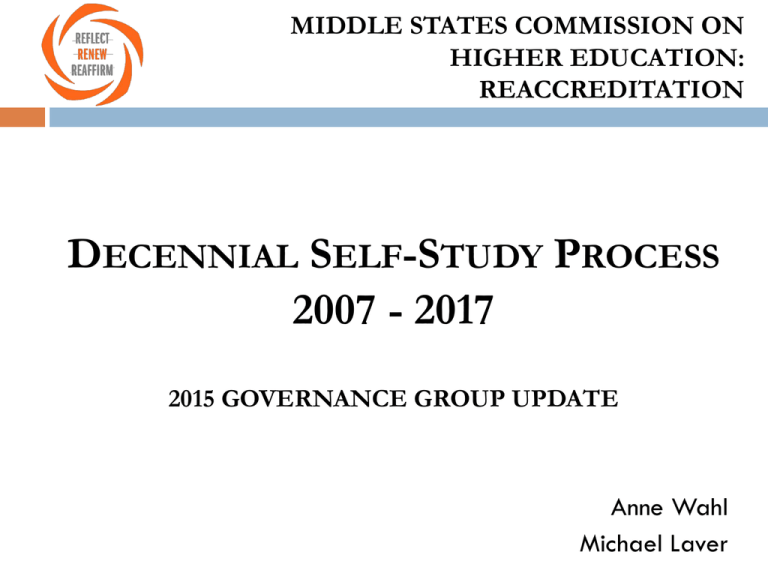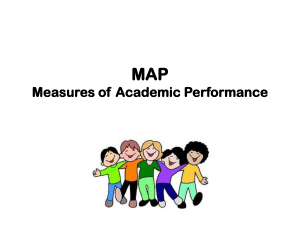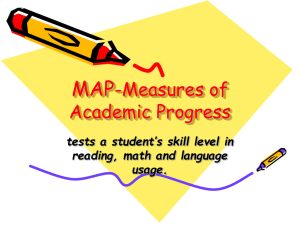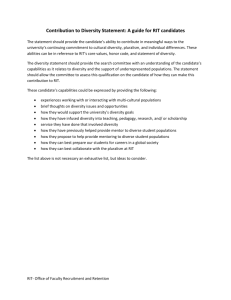Decennial Self-Study Process - Rochester Institute of Technology
advertisement

MIDDLE STATES COMMISSION ON HIGHER EDUCATION: REACCREDITATION DECENNIAL SELF-STUDY PROCESS 2007 - 2017 2015 GOVERNANCE GROUP UPDATE Anne Wahl Michael Laver Decennial Review Timeline 2015-16 Sept: Working Groups begin inquiry May 2016: Working Group reports due (reports form the self-study) June-August 2016 – Collect Feedback – Steering Committee review Sept. –November 2016: Collect campus feedback December-January – Steering Committee final review 2016-2017 February: final self study submitted March-April: evaluation team visit May: RIT response June: final accreditation action Campus Participation 2016 September - November: Collect campus feedback Similar to previous Middle States process Self-Study will be available to campus community Feedback will be collected electronically Steering Committee reviews and incorporates feedback Collaborative Implementation Project RIT Invited to participant in MSCHE Collaborative Implementation Project (CIP) Implementing the new Standards (now 7 from 14) and accreditation processes 15 Partner Institutions RIT’s “CIP” Team: Dr. Michael Laver, Self Study Co-Chair Dr. Anne Wahl, Self Study Co-Chair Dr. Christine Licata, RIT Accreditation Liaison Officer Steering Committee Membership Karen Barrows ’04 Bob Finnerty ’07 Joan Graham Paula Grcevic Clyde Hull Bridget Hurley Sandra Johnson Michael Laver Christine Licata Ed Lincoln ’79 Kevin McDonald Yin Pan Austin Sierra Thomas Smith Kim Sowers Greg Van Laeken Anne Wahl Kim E. VanGelder Secretary to the Institute, and Chief of Staff, Office of the President Chief Communications Officer, University News Assistant Vice President, Institutional Research and Policy Studies Professor, National Technical Institute for the Deaf Associate Professor, Saunders College of Business Student Government Representative Senior Vice President for Student Affairs Associate Professor, College of Liberal Arts, Co-chair Senior Associate Provost, Academic Affairs Assistant Vice President, Enrollment Management & Career Services Vice President/Associate Provost for Diversity & Inclusion, Office of the President Associate Professor, Golisano College of Computing and Information Sciences Student Government Representative Professor, School of Chemistry & Materials Science, College of Science Director, ITS Project Management Office Business Manager & Analyst for Global Programs Assistant Provost for Assessment & Accreditation, Co-chair BOT Member, CIO and VP, Eastman Kodak Company, ’86 BS Mathematics 7 Standards 1. Mission 2. 3. 4. 5. 6. 7. and Goals Ethics and Integrity Design and Delivery of Student Learning Experience Support of the Student Experience Educational Effectiveness Assessment Planning, Resources, & Institutional Improvement Governance, Leadership & Administration Working Groups – Inquiry Begins • Seven Standard Working Groups • Teams of faculty, staff, and students working on: Reviewing and reflecting on the documentation to determine to what extent RIT meets the standard/criteria Making recommendations for institutional improvement Responding to the research questions for each standard • One Compliance Working Group Reviewing documentation, policies, and procedures to determine to what extent RIT meets the standard/criteria Making recommendations for institutional improvement Working Groups • • Core Question-all Working Groups must answer: To what extent does RIT meet the criteria established for the standard? Working Group Research Questions Standard 1: Mission and Goals How effective is RIT, as a “student-centric” university, at preparing graduates for successful careers in a global society? (Linked to Strategic Plan 2015 Mission and Dimension One: Career Education and Student Success- Difference Maker I.2) To what extent do opportunities exist to enhance collaborative and interdisciplinary academic programs, research, and partnerships across the University? (Linked to Strategic Plan 2015 and Mission and Dimension Two: The StudentCentered Research University - Difference Maker II.1) Standard 2: Ethics and Integrity How do existing policies, practices, and procedures demonstrate RIT’s ongoing commitment to inclusive excellence for faculty, staff and students? (Linked to Strategic Plan 2015 and Dimension Three: Leveraging Difference Difference Maker III.7) To what degree is RIT positioned to satisfy the “affordability goal?” (Linked to Strategic Plan Dimension Four: Affordability and Return on Investment) Research Questions Standard 3: Design and Delivery of the Student Experience To what degree is RIT positioned to develop T-shaped graduates with the disciplinary depth and breadth across multiple skills and competencies? (Linked to Strategic Plan 2015 Dimension One: Career Education and Student Success Difference Maker I.1) Where do opportunities exist to expand and strengthen experiential learning experiences for all students? (Linked to Strategic Plan 2015 and Dimension One: Career Education and Student Success – Difference Maker I.1) Standard 4: Support for the Student Learning Experience To what degree do existing policies, procedures, practices, and conditions support on-time degree completion as defined by the various degree programs at RIT and given RIT’s emphasis on experiential learning? (Linked to Strategic Plan 2015 and Dimension One: Career Education and Student Success Difference Maker I.7) To what extent are the University’s recruitment and retention efforts, and planned efforts, meeting institutional enrollment goals? (Linked to Strategic Plan 2015 and Dimension One: Career Education and Student Success - Difference Maker I.7 and Dimension Three: Leveraging Difference - Difference Maker III.5) Research Questions Standard 5: Educational Effectiveness Assessment In what way does the assessment of student learning provide evidence that students have achieved RIT learning outcomes? (Linked to Strategic Plan 2015 and Dimension One: Career Education and Student Success - Difference Maker I.4) To what extent does RIT use assessment results for the improvement of educational effectiveness consistent with the mission? (Linked to Strategic Plan 2015 and Dimension One: Career Education and Student Success - Difference Maker I.4) Standard 6: Planning, Resources and Institutional Improvement To what degree are the University’s budgeting and resource allocation models datadriven and based on and guided by strategic planning, priorities, and ongoing institutional demands? To what extent does RIT leverage educational technology to improve access, maintain academic quality, and achieve desired learning outcomes while balancing costs? (Linked to Strategic Plan 2015 and Dimension Four: Affordability, Value and Return on Investment - Difference Maker 4.2) Research Questions Standard 7: Governance, Leadership, and Administration What evidence exists that the university has been successful in the implementation and transparency of the University’s mission, vision and goals? (Linked to RIT Strategic Plan/Difference Makers) Is RIT’s system of shared governance working effectively to benefit the constituencies that it serves? (Linked to RIT Policies B01, B02, B03, and B04). Ongoing Campus Communication Campus Presentations Accreditation Website https://www.rit.edu/president/middlestates/ Contact co-chairs or any Steering Committee Member Questions? Happy Autumn!





